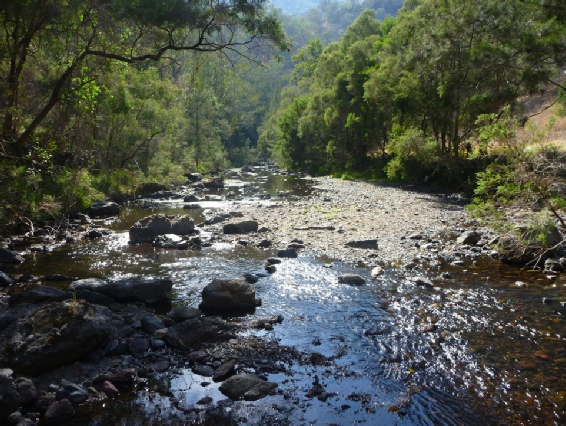

Oxley Wild Rivers National Park
Oxley Wild Rivers National Park
Ancient lands
Oxley Wild Rivers National Park is part of the Gondwana Rainforests of Australia World Heritage Area. The park contains some of the best examples of dry rainforest communities in Australia.
When you are out exploring the wet and dry eucalypt forests, grassy woodlands and heathlands of the park, look for native olives, lacebarks, shiny-
Rock hoppers
The varied plant communities of the Oxley Wild Rivers National Park provide a home for 350 animal species, including the largest confirmed population of brush tailed rock wallabies. Even though there are roughly 10,000 of this endangered species in the park, you’ll have to keep your eyes open to catch a glimpse of their bushy tail. Look for them jumping around rocky escarpments and granite outcrops or grazing on native grasses at dawn and dusk.
Jaw-
With dramatic ridges and gorges, towering rock outcrops and beautiful rivers and waterfalls, there is something new around every corner and you’ll be constantly amazed by the views. The sight of a majestic wedge-
A national first
Aside from spectacular scenery and abundant wildlife, the park also contains important historical sites, including the remains of Australia’s first commercial hydro-
Oxley Wild Rivers National Park, part of the Gondwana Rainforests of Australia World Heritage Area features rare dry rainforest, dramatic gorges and waterfalls, extensive wilderness areas, wild and scenic rivers and an amazing array of wildlife. It's best explored as a scenic drive along the Waterfall Wayexternal link.
Explore the Apsley Macleay Gorges, one of Australia’s largest gorge systems with incredible ridge top views and visit Wollomombi, the highest waterfall in NSW and a place sure to lift your spirit. Bushwalkers will love the multi-
Everything in the park is best seen up close – immerse your senses and yourself in this wild place while you camp, walk, paddle, picnic, cycle, horse ride, fish or swim.
Rainforests
The Apsley Macleay Gorges are a meeting point for moister eastern coastal and dry western floras, and some 950 native plant species have been identified, of which 36 are rare or threatened.
The dry rainforest that occurs throughout the park is of special interest. Dry rainforest is visible as dense, dark green patches throughout the gorges, favouring hollows where there is shelter from wind and sun, access to more ground water and where the slope is more stable. This vegetation is generally restricted to gullies and broad concave slopes facing south and east.
Dry rainforest communities in the gorges contain at least 187 plant species. These communities are diverse and range from tall, moist forests with rock orchids and felt ferns to shorter, drier communities with a mallee type habit where conditions are harsher.
Dry rainforest can survive in low rainfall areas and is characterised by species such as:
Moreton Bay fig
native olive
lacebark
shiny-
shatterwood
gorge mock-
scentless rosewood
red kamala.
The gorge wattle is a rare species that mainly grows in the Apsley Macleay gorges.
Grassy woodlands
Woodland occurs on most slopes, particularly on northerly and westerly aspects. The eucalypt dominating this woodland is forest red gum, identified by the bark on its trunk which sheds to expose white, grey or bluish patches. Silvertop stringybark and yellow box are also present.
Black cypress pine is sometimes associated with these eucalypts, and particularly favours areas of lower rainfall and steep, well drained soils such as the Dangars-
Various kinds of daisy bush occur in this gorge woodland as well as cassinia and Australian indigo.
Dry eucalypt forests
There's grassy tableland open forest around the rim of the gorge and on sheltered slopes, dominated by various eucalypts. The main species are:
New England stringybark
silvertop stringybark
yellow box
Hillgrove box
apple box
New England blackbutt
Hillgrove spotted gum.
Native broom and wild cherry are also common. The understorey is often sparse except for occasional wattles, blackthorn and grass trees.
Heathlands
Areas of hardy shrubland occur on the cliffs where the soil is too shallow and unstable for trees. Rapid drainage and strong winds also contribute to the shrubs' twisted and stunted appearance.
The cassinia, geebung, woolly pomaderris and mintbush are the most common species in the area. Because of the harsh conditions some species have adaptated to reduce water loss, (e.g. small leaves and stunted shapes). Wollomombi wattle and the rare Acacia ingramii are quite often found in this shrubland environment.
Because the conditions are extreme on the cliffs, quite a number of rare and uncommon shrubs are found there. These include:
broadleaf hopbush
Dodonaea rhombifolia
Dodonaea serratifolia
Bertya sp.
Hakea fraseri
Westringia sp.
Grevillea obtustiflora.
Native animals
Mammals
The park is rich in fauna, with over 350 species recorded, including 55 mammals. Twenty five of these mammal species are rare or threatened, including the endangered Hastings River mouse. The habitats with the most recorded species are tableland forests, river flats and dry rainforests, with many species at their western limits.
The most common macropods are:
grey kangaroos
wallaroos
red-
brush-
red-
The parma wallaby is also found in the park but is not common.
Oxley Wild Rivers National Park is a major refuge for the brush-
Other species found in the park include koalas, bats, wombats, bandicoots and numerous small ground mammals. Spotted-
Birds
The north-
Most striking of all the birds is the majestic wedge-
spotted quail-
ducks
robins
wagtails
crows
ravens
parrots
cockatoos
lorikeets
rosellas
scrubwrens
pigeons
doves
honeyeaters
wattlebirds.
Several bird species reach their western limits within the park.
Although not a common bird, the peregrine falcon (Falco peregrinus), is found around the world and across Australia. It is a highly specialised bird of prey, with long narrow wings, slender tail, and a short powerful beak. It's an effective hunter, plunging with extreme accuracy at high speedstake its prey in mid flight. In the 1960s peregrines suffered rapid decline due to the effects of DDT on their eggs, causing thinning of the shells. The species is recovering, and birds can be found nesting on cliff ledges in the park. Splashes of white around the gorges indicate likely nesting and roosting sites.
Amphibians and reptiles
There have been 38 reptile and 19 amphibian species recorded in Oxley Wild Rivers National Park. Skinks, tortoises, lizards, snakes, frogs and fish occur in the park, particularly on the river flats.
A total of 18 fish species have been recorded. Of note is the long-
Australian bass is found well up the Apsley-
Remember all recreational fishers now need a fishing licence. The bag limit for bass is 2 per day, and only 1 over 35 cm in possession.
Invertebrates
A limited invertebrate survey has been undertaken in the Kunderang Brook Karst (limestone cave) System. A total of 16 species have been identified to date including lice, beetles, isopods, a mite, spiders and snails. Some of the species are endemic to the Kunderang Brook area and include a new genus and several new species, plus an unnamed snail.
© State of New South Wales through the Office of Environment and Heritage
Click the link for more information about Oxley Wild Rivers National Park
Green Gully Creek

Photos of Oxley Wild Rivers National Park -
Photos of Green Gully 4 Day Full Pack Walk
